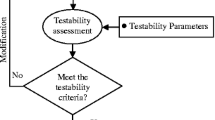Abstract
A global design for testability algorithm is offered in this paper. First, a test point candidate set is obtained to simplify the test point placement problem; the principle of selective tracing is offered to get a sequential test point placement solution, which is used as the initial solution of the global algorithm. Using this initial value, abranch & bound algorithm is then offered to obtain a global design for testability solution. Finally, a new test length analyser is offered to evaluate the global design for testability.
Similar content being viewed by others
References
Chen T H, Breuer M A. Automatic design for testability via testability measures.IEEE Trans. CAD, 1985, CAD-4: 3–11.
Krishnamurthy B. A dynamic programming approach to the test point insertion problem. In: 24th ACM/IEEE DAC, 695–705, 1986.
Xiang Dong. A knowledge based design for testability.Acta Electronica Sinica, 1991, 19(3): 106–109.
Xiang Dong, Wei Daozheng. A global test point placement algorithm. In: Proc. of the 5-th Int. VLSI Design Conf., 227–232, IEEE Computer Society Press, Jan., 1992.
Chickermane V. Patel J H. An optimization based approach to the partial scan design problem.IEEE ITC, 1987: 377–386.
Cheng K T, Agrawal V D. An economical scan design for sequential logic test generation.IEEE FTCS, 1989: 28–35.
Xiang Dong. SCTM: A signal conflict oriented testability measure.Chinese Journal of Computers, 16(4): 331–337.
Xiang Dong, Wei Daozheng, Chen S S. Probabilistic models for estimation of random and pseudorandom test length.Journal of Computer Science & Technology, 1992, 7(2): 164–174.
Hideo Fujiwara, Computational complexity of controllability/observability problems for combinational circuits.IEEE Trans. Comput., 1990, 39(6): 762–767.
Xiang Dong. Design for Testability and applications to test generation, Ph. D dissertation, Institute of Computing Technology, Academia Sinica, Feb., 1993.
Savir J, Bardell H P. On random test length.IEEE ITC, 1983: 95–105.
Wunderlich H J. Multiple distributions for biased random test patterns.IEEE ITC, 1988, 236–244.
Chin C K, McCluskey E J. Test length for pseudorandom testing.IEEE Trans. Comput., 1987, C-36: 252–256.
Author information
Authors and Affiliations
Rights and permissions
About this article
Cite this article
Xiang, D., Wei, D. GLOBAL: A design for random testability algorithm. J. of Compt. Sci. & Technol. 9, 182–192 (1994). https://doi.org/10.1007/BF02939500
Received:
Revised:
Issue Date:
DOI: https://doi.org/10.1007/BF02939500




